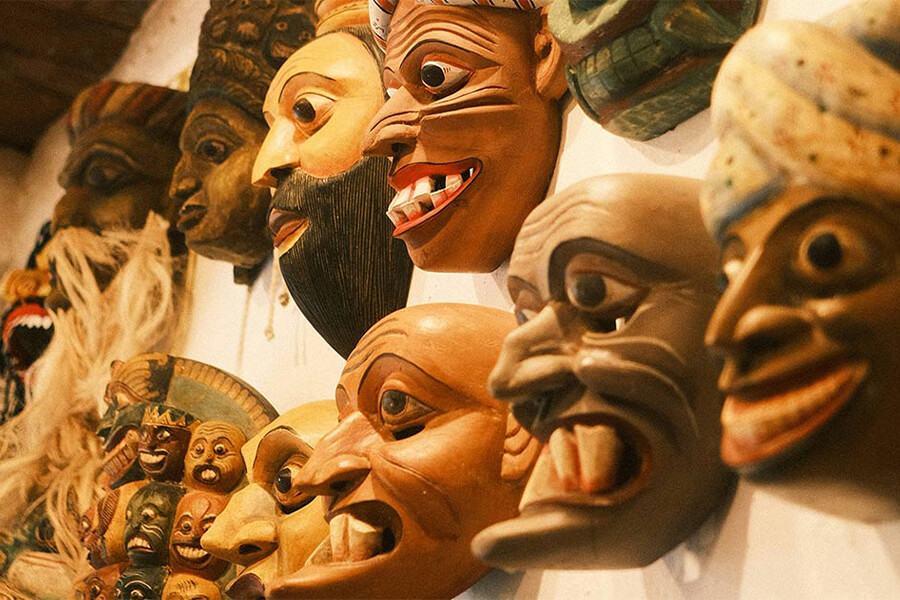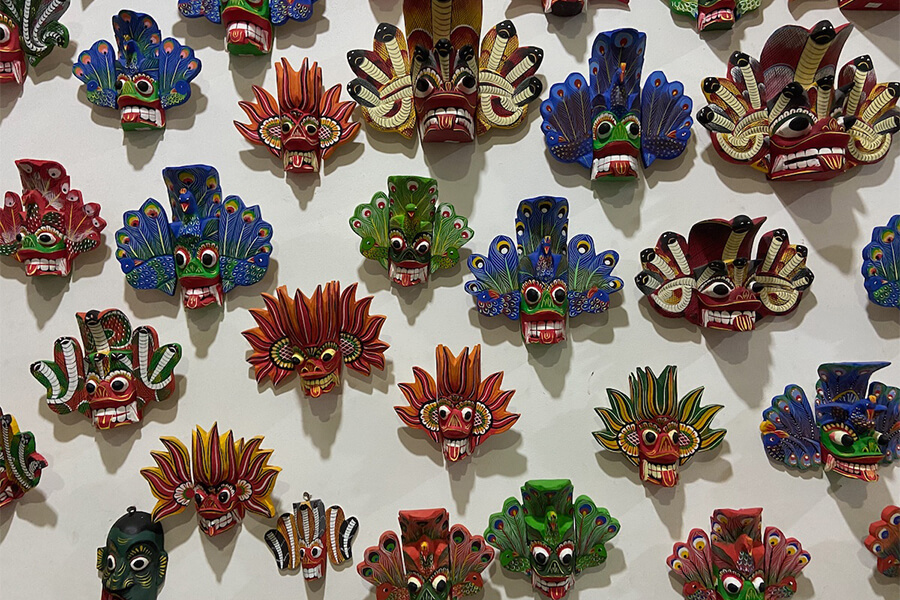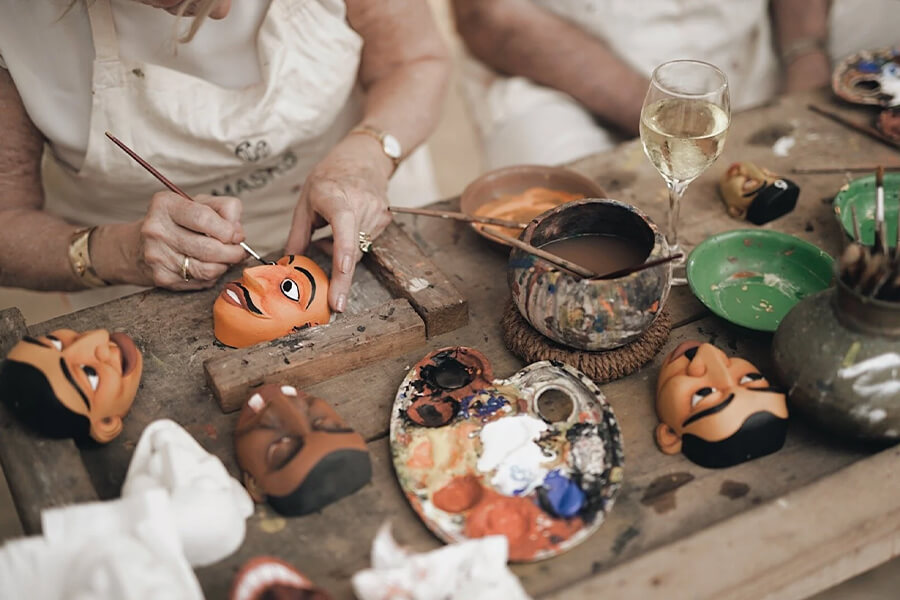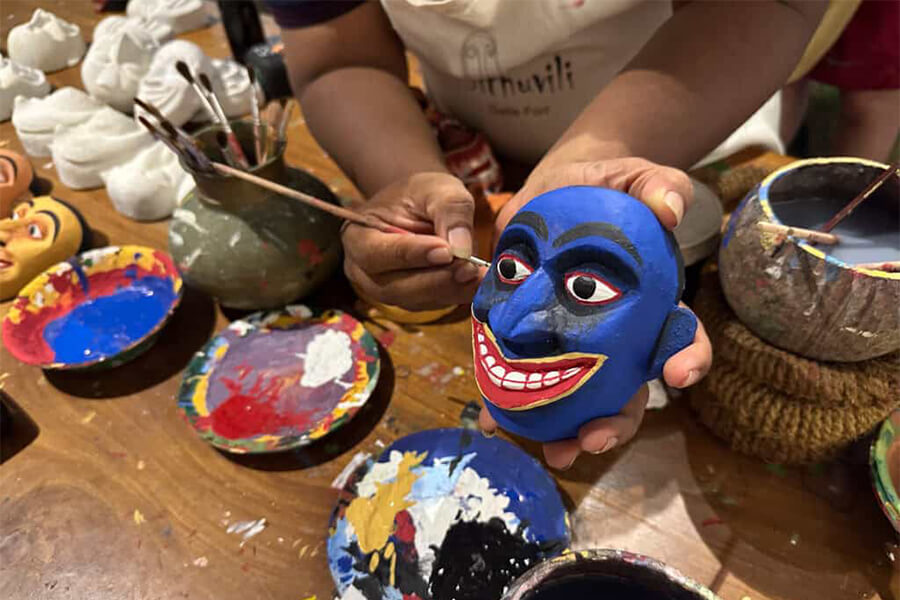When you first see the vivid, bulging eyes and fierce grins of masks in Sri Lanka, it feels like stepping into another world. These carved faces are not just souvenirs; they are living symbols of healing, protection, satire, and spirituality, passed down through generations. Today, travelers can encounter this art form in coastal villages like Ambalangoda, at temple festivals, and even in workshops organized by experienced artisans and Sri Lanka local tour operators. Understanding the story behind each Sri Lanka mask helps you appreciate performances, rituals, and even the “simple” decorative piece hanging on a guesthouse wall in a much deeper way.
History and Origins of Sri Lanka Masks
Early Rituals and Folk Beliefs Behind Sri Lanka Mask Culture
Long before masks in Sri Lanka became popular with tourists, they were deeply rooted in village life. Communities believed that illness, misfortune, and unexplained events could be caused by spirits, demons, or imbalances in the unseen world. To restore harmony, people turned to ritual dance, drumming, and the use of powerful Sri Lanka masks.
In coastal and southern regions, healers and dancers used masks in Sri Lanka during exorcism ceremonies, night-time healing rituals, and fertility blessings. Each mask in Sri Lanka represented a specific character: a demon of sickness, a mischievous spirit, or a benevolent deity. By performing dramatic dances wearing these carved faces, they believed they could scare away harmful forces or negotiate with them through offerings, music, and humor.
Over time, these rituals shaped a distinctive Sri Lanka mask culture that blended folk beliefs with regional storytelling. Even today, when you watch a traditional performance, you are seeing echoes of centuries-old village practices, carefully preserved by families of dancers and mask-makers.
Influence of Religion and Local Kingdoms
As Buddhism and Hinduism became firmly rooted on the island, religious ideas influenced the forms and meanings of masks in Sri Lanka. Characters from Buddhist Jataka tales, Hindu epics, and local guardian deities were gradually woven into performances. Some Sri Lanka masks depict divine protectors, cobra spirits, or celestial beings who help defend villages from danger.
Local kingdoms also played an important role. Royal courts sometimes patronized performance troupes, inviting them to entertain at palaces and festivals. This support encouraged more elaborate choreography, costumes, and finely carved masks in Sri Lanka. What began as rural healing and exorcism practice evolved into a rich theatrical tradition linked to both religion and royal ceremony, helping Sri Lanka masks survive through political changes and social transformation.
Main Types of Traditional Masks in Sri Lanka
Traditional masks in Sri Lanka are generally grouped into three main categories, each with its own style, purpose, and atmosphere: Kolam, Raksha, and Sanni.
Kolam - Storytelling and Satirical Mask in Sri Lanka
Kolam is a form of folk theater that uses humorous, dramatic, and sometimes sharp social commentary. Kolam mask in Sri Lanka performances combine dance, dialogue, and music to tell stories about village life, mythological events, and even everyday problems like jealousy, greed, or laziness.
Kolam characters wear expressive masks in Sri Lanka: kings and queens with refined, gentle faces; clowns and village idiots with exaggerated features; demons, spirits, and animals that provoke both laughter and curiosity. The goal is not only to entertain but also to teach. Through jokes and satire, Kolam shows the consequences of bad behavior and highlights virtues such as honesty and respect.
For travelers, watching a Kolam show is one of the best ways to see how traditional Sri Lanka masks function as tools for storytelling and social reflection, not just as decorative art. If you are exploring southern coastal towns, ask performers or cultural centers if there are community Kolam shows, especially around festivals and village celebrations.
Raksha - Protective and Demon Sri Lanka Masks
Raksha, meaning “demon” or “protector,” refers to a dramatic family of masks in Sri Lanka that portray fierce mythical beings. These Sri Lanka masks are instantly recognizable: wide eyes, flaring nostrils, sharp fangs, and elaborate headdresses filled with flames, snakes, or feathers.
Despite their frightening appearance, Raksha Sri Lanka mask designs often represent protective forces that chase away evil spirits. Popular characters include Naga Raksha (cobra demon), Gurulu Raksha (bird-like demon), and Mayura Raksha (peacock demon). Each design combines power, beauty, and strong symbolic meaning, drawn from ancient legends and local guardian beliefs.
Raksha masks in Sri Lanka are commonly used in processions and festival dances. You may see them during Perahera-style parades or at coastal rituals. They are also among the most popular styles sold in craft shops, as visitors are drawn to their vibrant colors and dramatic expressions.
Sanni - Healing and Exorcism Sri Lanka Mask Traditions
Sanni masks are directly linked to healing practices. In traditional beliefs, different illnesses were thought to be caused by specific demon-like entities, each with its own personality and symptoms. Sanni Yakuma is the collective term for a series of rituals and dances aimed at driving out these spirits.
Each Sanni Sri Lanka mask represents a particular type of suffering: fever, paralysis, blindness, vomiting, and other conditions. During a healing ritual, dancers wearing these masks in Sri Lanka enact the origin of the disease, negotiate with the demon, and symbolically defeat it. The patient and community participate through offerings, chanting, and observation.
Today, full Sanni rituals are less common, but the masks themselves are still carved by skilled artisans for cultural preservation and educational displays. When you see Sanni Sri Lanka masks in a museum or workshop, you are looking at a detailed catalog of human suffering and the community’s traditional response: art, dance, and ritual.
Symbolism and Meanings of Sri Lanka Masks
Colors, Facial Expressions and What They Represent
One of the fascinating aspects of masks in Sri Lanka is how color and expression carry meaning. Artisans carefully choose pigments and shapes to convey emotion, power, and purpose.
Red often suggests energy, danger, or intense emotion. Many demonic or fierce Sri Lanka masks feature red faces or tongues to show their fiery temper. Blue and green can hint at supernatural qualities, the sea, or the forest, while yellow and gold are linked to royalty, divinity, and prosperity.
Facial structure is equally important. Bulging eyes, bared teeth, and flared nostrils in a mask in Sri Lanka communicate rage, supernatural power, or protective aggression. Softer, rounded eyes, relaxed mouths, and elegant noses suggest nobility, kindness, or wisdom. When you visit a workshop, ask the carver to explain the symbolism of specific Sri Lanka masks; their explanations often reveal layers of cultural meaning that you might otherwise miss.
Popular Characters in Traditional Masks In Sri Lanka
Within this rich universe of masks in Sri Lanka, certain characters appear again and again:
- Regal kings and queens inspired by historical rulers and mythological figures, wearing refined Sri Lanka masks that emphasize dignity and calm.
- Comic characters such as village drunkards, know-it-alls, and gossipers, whose exaggerated mask in Sri Lanka designs highlight human flaws for humorous effect.
- Animal spirits like cobras, birds, and peacocks, symbolizing protection, wisdom, or beauty in Raksha-style Sri Lanka masks.
- Sanni demons, each showing specific symptoms or emotional states linked to traditional healing rituals.
For travelers interested in photography and culture, recognizing these recurring figures makes performances more enjoyable. You begin to read masks in Sri Lanka almost like a visual language, with each face telling you what role it plays in the story.
How Traditional Masks In Sri Lanka Are Made
Materials, Wood and Natural Pigments
Authentic masks in Sri Lanka are still carved mainly from soft, lightweight woods that are easy to shape and comfortable to wear during long performances. A common choice is kaduru (strychnine tree) or similar local woods, selected for their fine grain and durability. The wood is seasoned and dried properly so the finished Sri Lanka mask does not crack or warp over time.
Natural pigments were traditionally made from minerals, plant extracts, and other organic sources, then mixed with a binder to create long-lasting paint. While some workshops now use modern paints for convenience, many still aim to match the bold yet earthy tones of older masks in Sri Lanka. Finishing touches, such as coconut-fiber hair, fabric, and shells, help bring the character to life.
If you have the chance, visiting a carving village or artisan family is one of the most rewarding cultural experiences. Skilled craftspeople are usually proud to explain the materials they use and the difference between a ceremonial Sri Lanka mask and a purely decorative one.
From Sketch to Finished Mask in Sri Lanka Workshops
The creative process behind masks in Sri Lanka usually starts with an idea rooted in tradition: a specific demon, deity, animal, or comic figure. Artisans may sketch the face on paper or draw guidelines directly onto the wood block. Then, using chisels and knives, they carefully remove wood to create contours: brow, nose, cheeks, mouth, and eyes.
After the basic shape is defined, finer tools carve details—wrinkles, teeth, scales, feathers, or jewelry. The smoother the surface, the better it will take paint, so sanding is an important step. Once the carver is satisfied, the mask is primed and painted. Each layer of color on a Sri Lanka mask is applied with attention to balance and symbolism, preserving traditional patterns while sometimes adding modern touches.
In many workshops open to visitors, you can observe each stage, and some even offer short classes where you can paint a small mask in Sri Lanka to take home. These hands-on experiences help you appreciate how much time and knowledge goes into every piece.
Where and How Travelers Can Experience Masks in Sri Lanka
For cultural travelers, the goal is not only to buy masks in Sri Lanka but to experience the performances and communities that keep this art alive. Here are a few practical ways to do that:
- Visit coastal craft towns and traditional carving centers, where numerous families specialize in Sri Lanka masks. Many homes double as workshops and small galleries.
- Look for cultural shows that feature Kolam or Raksha dances. Even if modernized for tourism, they often preserve original choreography and use authentic masks in Sri Lanka.
- Explore museums and cultural institutes that curate historic Sri Lanka mask collections, providing context about ritual use, regional styles, and evolution over time.
If you prefer a structured itinerary, consider booking with reputable sri lanka local tour operators who focus on heritage and crafts. They can arrange visits to artisan families, ensure fair compensation for demonstrations, and help bridge the language gap so you can ask detailed questions about each mask in Sri Lanka you see.
Buying and Caring for Traditional Masks in Sri Lanka
For many travelers, a hand-carved Sri Lanka mask is the perfect souvenir—beautiful, meaningful, and easy to display at home. However, it’s worth knowing a few tips before you buy:
- Distinguish between mass-produced items and genuine handmade masks in Sri Lanka. Handmade pieces often show subtle irregularities and deeper carving, while mass-produced ones may look flatter or identical to each other.
- Ask the seller about the wood type and whether the mask is suitable for hanging in humid or very dry climates. Good-quality Sri Lanka masks should be properly dried and sealed.
- If you are interested in traditional ritual designs like Sanni or Raksha, be respectful. Some motifs have strong cultural and spiritual meanings. Buying them is fine, but treat them as art with a story, not just decoration.
To care for your mask in Sri Lanka once you’re home, keep it out of direct sunlight to prevent fading, dust it gently, and avoid exposing it to rapid temperature changes. If you value authenticity, keep any label or note from the artisan—it can help preserve the story of how and where your Sri Lanka mask was made.
Responsible and Respectful Cultural Engagement
As interest in masks in Sri Lanka grows, it’s important for visitors to support this heritage in a responsible way. Whenever possible:
- Choose workshops and performers who clearly rely on their craft as a main source of income.
- Pay fair prices for handmade Sri Lanka masks, understanding that carving and painting require time and expertise.
- Ask permission before photographing rituals or close-up details, especially during private ceremonies using traditional masks in Sri Lanka.
Travelers who approach this art form with curiosity and respect help keep the tradition alive. Your ticket to a performance, your visit to a small family workshop, or your purchase of an ethically sourced Sri Lanka mask all contribute to sustaining the next generation of dancers and carvers.
What Traditional Masks Reveal About Sri Lanka
In the end, masks in Sri Lanka are much more than colorful objects on a wall. They are a window into how communities understand illness and healing, how they laugh at themselves through satire, and how they honor protective forces and spiritual stories. Watching dancers animate these carved faces, or listening to an artisan explain the meaning behind a particular Sri Lanka mask, gives you a richer perspective on the island’s identity.
Whether you encounter a healing Sanni mask, a fierce Raksha demon, or a playful Kolam character, each mask in Sri Lanka carries generations of knowledge and belief. By taking the time to learn about them—and perhaps bringing one carefully chosen piece home—you connect your journey with a living tradition that continues to evolve while staying true to its roots.







